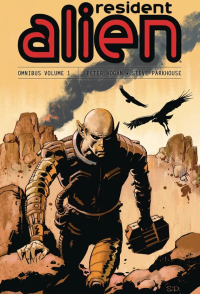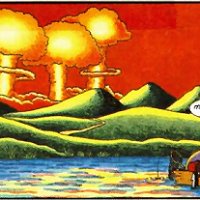Category Archives: TV
 Over the last few weeks, I’ve watched (on Netflix) two seasons of Resident Alien, a SyFy television adaptation of the same-named comic series. A third season finished airing on the SyFy channel earlier this month but isn’t yet available on Netflix.
Over the last few weeks, I’ve watched (on Netflix) two seasons of Resident Alien, a SyFy television adaptation of the same-named comic series. A third season finished airing on the SyFy channel earlier this month but isn’t yet available on Netflix.
Both the comic and its adaptation are stories about an alien stranded on Earth, but the adaptation is a severe departure from its source text. Worse from my point of view, the television show is an Idiot Clown comedy, and I’ve never cared for those. In its favor, though, it stars the inimitable Alan Tudyk.
The pity is that the comic story is much better — and much smarter — than the adaptation but has been almost entirely discarded.
Continue reading
7 Comments | tags: adaptations, aliens, comics, science fiction, science fiction TV | posted in Sci-Fi Saturday, TV
 Over the last few weeks, on Amazon Prime, I’ve watched all 30 episodes of the first season of Three-Body, the Chinese television adaptation of the 2006 science fiction novel The Three-Body Problem, by Liu Cixin.
Over the last few weeks, on Amazon Prime, I’ve watched all 30 episodes of the first season of Three-Body, the Chinese television adaptation of the 2006 science fiction novel The Three-Body Problem, by Liu Cixin.
That’s the first book of the Remembrance of Earth’s Past trilogy. The second and third books are The Dark Forest (2008) and Death’s End (2010). I haven’t (yet) read the novel, but the adaptation is said to be reasonably faithful to the text.
I enjoyed the TV adaptation but found certain aspects of it frustrating. I’m curious to see if my frustrations are due to the adaptation or inherent in the novel.
Continue reading
18 Comments | tags: adaptations, Liu Cixin, science fiction TV, SF TV | posted in Sci-Fi Saturday, TV
 I’ve written many times here about my issues with TV and movie adaptations of existing stories. Short synopsis: I usually find them lacking. Especially the more recent attempts. Extra especially the live-action adaptations of animated stories. So many are just plain awful.
I’ve written many times here about my issues with TV and movie adaptations of existing stories. Short synopsis: I usually find them lacking. Especially the more recent attempts. Extra especially the live-action adaptations of animated stories. So many are just plain awful.
I don’t mean they fill me with awe, at least not the good kind. Sometimes I am a bit in awe that the people involved all thought it was a good thing. Emperor’s New Clothes, perhaps? No one wanted (or dared) to say anything?
Recently, I got to thinking about the worst adaptations I’ve seen…
Continue reading
13 Comments | tags: adaptations, Agatha Christie, Cowboy Bebop, Preacher (TV series), Sandman, storytelling, The Andromeda Strain, Tony Hillerman | posted in Books, Movies, TV
 This post’s title is a bit vague. Someone familiar with my interests might suppose it has something to do with the Well World series by Jack L. Chalker — I’ve posted about it before. I won’t draw out whatever suspense you might have — the well in question is humanity’s wellspring of stories.
This post’s title is a bit vague. Someone familiar with my interests might suppose it has something to do with the Well World series by Jack L. Chalker — I’ve posted about it before. I won’t draw out whatever suspense you might have — the well in question is humanity’s wellspring of stories.
The revisiting is our love of nostalgia in all the sequels, serials, remakes, reboots, adaptations, borrowings, homages, parodies, and pastiches. To name but some. And make no mistake, all stories have elements of other stories. Boil stories down enough and the reductions begin to look similar (the infamous seven plots).
But I find myself bemused by how obsessed we get about drinking from the same well over and over when there are so many other interesting wells.
Continue reading
22 Comments | tags: adaptations, reboots, remakes, sequels, storytelling | posted in Books, Movies, TV
 I’ve been a fan of Japanese anime since the 1980s, but in the last decade or so I’ve come to appreciate it even more (because what’s been coming out of Hollywood lately so often has little redeeming value). As fans of the genre know, anime can be as creative and engaging as any form of storytelling you care to name.
I’ve been a fan of Japanese anime since the 1980s, but in the last decade or so I’ve come to appreciate it even more (because what’s been coming out of Hollywood lately so often has little redeeming value). As fans of the genre know, anime can be as creative and engaging as any form of storytelling you care to name.
Lately, I’ve begun exploring the Japanese media franchise, Lupin the Third (aka Lupin III or Lupin the 3rd). It began back in 1967 and comprises multiple manga, at least six anime TV series, over a dozen films, and other related media.
It taps into our love of master thieves. The fictional monkey-faced Lupin III is acknowledged worldwide as the greatest (and most fun) thief in the world.
Continue reading
16 Comments | tags: anime, Japanese anime, Lupin III, Lupin the Third, thieves | posted in Books, Movies, TV
 I still haven’t gotten used to writing “2023” — it feels like a misspelling. Perhaps in part because it’s an odd number. It’s not prime, and it’s kind of cute that it’s the product 7×17×17=2023. Lucky triple sevens! And a full house, sevens over aces. (Numerology would be another of those things that are fun but which I don’t believe.)
I still haven’t gotten used to writing “2023” — it feels like a misspelling. Perhaps in part because it’s an odd number. It’s not prime, and it’s kind of cute that it’s the product 7×17×17=2023. Lucky triple sevens! And a full house, sevens over aces. (Numerology would be another of those things that are fun but which I don’t believe.)
My 2022 plan for Serious Spring Cleaning didn’t end up nearly aggressive as planned. There’s still too much junk. And still too many (piles of) notes and notebooks.
So: Serious Spring Cleaning, take two, and another edition of Friday Notes.
Continue reading
17 Comments | tags: Ally McBeal, Chelsea Handler, Knives Out, Lilyhammer, Mission: Impossible, Octavia E. Butler, Tom Cruise | posted in Books, Friday Notes, Movies, TV
 Over the last nine posts I’ve been pondering the topic of Who Can Play Who when it comes to adaptations of existing works. To wrap things up, and because ten is a magic number to us humans, it seems reasonable to try to boil it all down to something coherent. If that’s even possible.
Over the last nine posts I’ve been pondering the topic of Who Can Play Who when it comes to adaptations of existing works. To wrap things up, and because ten is a magic number to us humans, it seems reasonable to try to boil it all down to something coherent. If that’s even possible.
I find myself conflicted sometimes between what I’ll call a stage play sensibility that allows huge latitude in casting actors versus my sensibilities about live-action adaptations of well-established existing properties.
I think that changes the equation.
Continue reading
14 Comments | tags: actors, adaptations, characters, gender, race, women | posted in Movies, Opinion, Society, TV
 Women, in most societies, have long suffered as second-class citizens. In the beginning it was due to biology, but modern cultures generally erase those differences. Paradoxically, women have historically also held a revered position (“Women and children first!”). Art, literature, and social practice, all elevate them above men, albeit selectively.
Women, in most societies, have long suffered as second-class citizens. In the beginning it was due to biology, but modern cultures generally erase those differences. Paradoxically, women have historically also held a revered position (“Women and children first!”). Art, literature, and social practice, all elevate them above men, albeit selectively.
Ironically, elevation is also a problem. In at least two ways. Putting anyone on a pedestal is never a good idea. That’s a topic for another time. There is also the zero-sum version of elevation: glorifying one group while disparaging, even attacking, another. That also is never a good idea.
As it applies to movie and TV roles, it’s the topic I want to discuss here.
Continue reading
12 Comments | tags: actors, female characters, gender, women | posted in Movies, Society, TV
 Recently I’ve been thinking (and posting) about acting roles in adaptations of existing works, especially of comics and animations. A few months ago, I ventured down the YouTube rabbit hole of fan media commentary channels where the topic is a common one. Fans naturally have strong opinions about their favorite characters.
Recently I’ve been thinking (and posting) about acting roles in adaptations of existing works, especially of comics and animations. A few months ago, I ventured down the YouTube rabbit hole of fan media commentary channels where the topic is a common one. Fans naturally have strong opinions about their favorite characters.
I’ve long said sexual differences make social gender issues more challenging than social race issues (because race is a social construct). The issue of gender swapping is likewise more challenging than that of race swapping.
Here be dragons of objectification, exploitation, and the Male Gaze.
Continue reading
4 Comments | tags: actors, beauty, female characters, gender, race, women | posted in Movies, Society, TV
 I seem to have a penchant for trilogy posts. It wasn’t intentional this time, but I ended up writing a trilogy of posts [1, 2, 3] about the Netflix adaptation of The Sandman (1989-1996), the much-loved graphic novel authored by Neil Gaiman (and drawn by various artists).
I seem to have a penchant for trilogy posts. It wasn’t intentional this time, but I ended up writing a trilogy of posts [1, 2, 3] about the Netflix adaptation of The Sandman (1989-1996), the much-loved graphic novel authored by Neil Gaiman (and drawn by various artists).
The Netflix adaptation offers some good examples of actor swapping, which has been my theme lately. Ultimately, I think the real problem is realistic live-action adaptations of singularly and visually well-defined drawn or animated characters. For instance: Superman, Homer Simpson, and Mickey Mouse.
When real people portray them, race and gender come into play.
Continue reading
6 Comments | tags: actors, adaptations, gender, race | posted in Movies, Society, TV
 Over the last few weeks, I’ve watched (on Netflix) two seasons of Resident Alien, a SyFy television adaptation of the same-named comic series. A third season finished airing on the SyFy channel earlier this month but isn’t yet available on Netflix.
Over the last few weeks, I’ve watched (on Netflix) two seasons of Resident Alien, a SyFy television adaptation of the same-named comic series. A third season finished airing on the SyFy channel earlier this month but isn’t yet available on Netflix. Over the last few weeks, on Amazon Prime, I’ve watched all 30 episodes of the first season of
Over the last few weeks, on Amazon Prime, I’ve watched all 30 episodes of the first season of 
 This post’s title is a bit vague. Someone familiar with my interests might suppose it has something to do with
This post’s title is a bit vague. Someone familiar with my interests might suppose it has something to do with 
 I still haven’t gotten used to writing “2023” — it feels like a misspelling. Perhaps in part because it’s an odd number. It’s not prime, and it’s kind of cute that it’s the product 7×17×17=2023. Lucky triple sevens! And a full house, sevens over aces. (Numerology would be another of those things that are fun but which
I still haven’t gotten used to writing “2023” — it feels like a misspelling. Perhaps in part because it’s an odd number. It’s not prime, and it’s kind of cute that it’s the product 7×17×17=2023. Lucky triple sevens! And a full house, sevens over aces. (Numerology would be another of those things that are fun but which  Over the last nine posts I’ve been pondering the topic of
Over the last nine posts I’ve been pondering the topic of  Women, in most societies, have long suffered as second-class citizens. In the beginning it was due to biology, but modern cultures generally erase those differences. Paradoxically, women have historically also held a revered position (“Women and children first!”). Art, literature, and social practice, all elevate them above men, albeit selectively.
Women, in most societies, have long suffered as second-class citizens. In the beginning it was due to biology, but modern cultures generally erase those differences. Paradoxically, women have historically also held a revered position (“Women and children first!”). Art, literature, and social practice, all elevate them above men, albeit selectively. I seem to have a penchant for trilogy posts. It wasn’t intentional this time, but I ended up writing a trilogy of posts [
I seem to have a penchant for trilogy posts. It wasn’t intentional this time, but I ended up writing a trilogy of posts [











